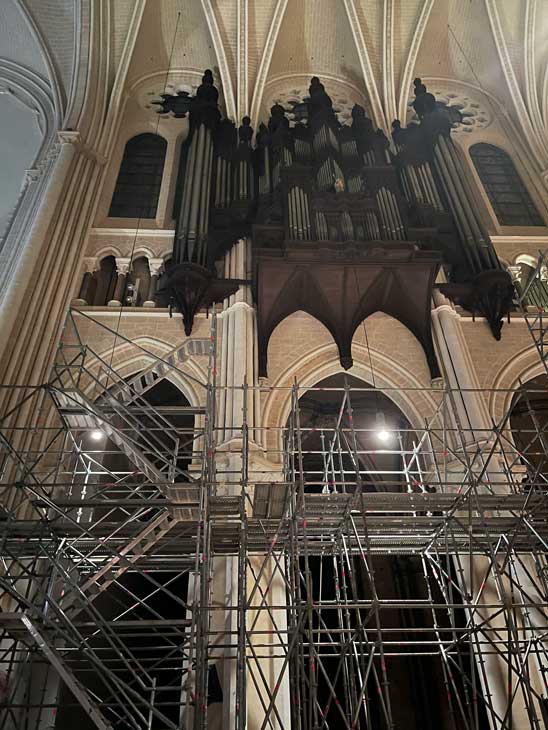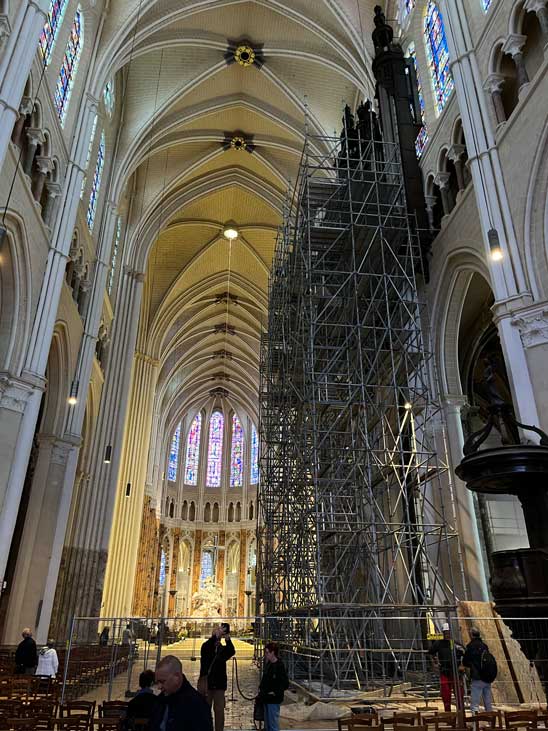by Philippe Lefebvre, President of the Association des Grandes Orgues de Chartres *,
with the kind permission of Chartres Sanctuary of the World
For several weeks now, a huge scaffolding has been standing in the nave of the cathedral: the dismantling of the great organ of the cathedral has begun, the first stage of a three-year project, which includes the restoration of the organ case, classified as a historical monument, one of the oldest in France, and the reconstruction of the instrumental part.
The reasons, the objectives, the stakes
At the end of the last concert of the great organ last September, some listeners were asking why it was necessary to rebuild this instrument, which still had the illusion of being a great organ. Here are some of the reasons.
Until the 1970s and ’75s, organ building was still part of the post-war reconstruction movement. They were carried out by companies that had become industrialized, because reconstruction had to be done quickly, often with limited means. At the same time and in the same way as in the construction industry, new materials appeared, such as concrete, synthetic wood, steel beams, etc. The traditional and noble materials are being replaced and the know-how of organ building, an age-old craft, is gradually being lost. The organ builders also took up these “novelties”, which they experimented with because of their economic interest and the simplicity of their implementation. Organs with electrical transmission were also built, which was simpler and faster, although there was no vision of the reliability and durability of these systems, which were still in their infancy and often specific to each company. In addition, there is the new idea that an organ must be able to play the entire repertoire (from the 16th to the 20th century), and that in order to achieve this, as many pipes as possible must be installed, which results in “stuffing” the instruments, reducing the size of the pipes (being narrower, they take up less space, so more can be installed…), without taking into account the case, accessibility for maintenance, and the space necessary for the instrument to breathe and for the sounds to develop naturally.
Like many other instruments built or rebuilt between 1950 and 1980, the great organ of Chartres was affected by this approach. It was quickly realized that this approach led to a dead end, both technically and in terms of the sound result. Indeed, after a few years, the electrical transmission failed, the combination system had to be replaced completely, then the keyboards themselves as well as other functions. The pipes, many of which, for economic reasons, were made of only 50% tin (instead of 75 or 80%), others of chipboard instead of oak, could not produce the right sound. Under perfusion for several decades, the great organ of Chartres has gradually seen pipes become mute, essential functions disappear, and could not be repaired, because they were obsolete materials, of which there are not even spare parts anymore… The number of breakdowns has multiplied, causing the cancellation of concerts.
The objective today is to build an organ in adequacy with the case (if it is monumental, it is one of the shallowest in France with little interior space), to answer the cultural and religious needs by an instrument with a real musical personality, proportioned to the acoustics of the cathedral, to guarantee its durability by its design, first quality materials and proven transmission systems. Over the centuries, the case has never been dismantled and each time (in the 19th and 20th centuries) it has been modified, added to, stacked, without taking into account the previous state, the deterioration of time on the old parts, etc…

The scaffolding under construction for the dismantling of the buffet and the instrument.

This is why the current dismantling stage is crucial: it will allow us to remove inappropriate and cumbersome additions dating from the 20th century, windchests superimposed one on top of the other, which do not allow the pipes to unfold their sound, but also to reach parts that are not easily accessible, in order to closely analyze the different parts of the case and the frame, and to make decisions adapted to each element and its condition.
The stakes of such a project are multiple: respect and restoration of an exceptional case of our heritage, tradition and nobility of French organ building, accessibility of all the internal parts to facilitate maintenance and thus the durability of the instrument, modernity and creativity by ensuring the use of proven technologies today in organ building. To this end, a consultation was established between the project owner (the Cultural Affairs Department of the Centre-Val de Loire region), the project manager (a state-approved technical consultant), the titular organist, and the Association des Grandes Orgues de Chartres.
In order to support this process, the Association des Grandes Orgues de Chartres has gathered the opinion of many organists on the nature of the project. This has allowed us to define a program of work for the construction of the new instrument, which will be inspired by French organ building: it will have four manuals and about fifty stops, and will be equipped with both mechanical transmissions of the secular tradition of organ building and electrical and electronic devices using materials that have been proven in Europe for decades.
This operation was made possible thanks to significant funding from the State (75% of the amount), the support of local authorities (Region, Department, City of Chartres) and the association Chartres, sanctuary of the world.
Given the stakes involved, the contracting authority set up a procedure for selecting companies by means of a jury made up of organists and qualified persons, a jury in which the assigning clergy and the titular organist, the association of the Great Organs of Chartres and the association Chartres, sanctuary of the World were involved.
At the end of the consultation, a group of three French organ builders was chosen: the Muhleisen company (Strasbourg), the Chevron company (Corrèze) and the harmonist Bertrand Cattiaux who will be in charge of the sound part.
In three years, the great organ will resound under the centuries-old vaults of the cathedral. A moment of celebration that we will share with joy.
Original article published in the Letter from Chartres Sanctuary of the World (December 2022)
* Philippe Lefebvre is titular of the great organs of the cathedral of Notre-Dame de Paris; and former titular of those of the cathedral of Notre-Dame de Chartres (1976 to 1985).